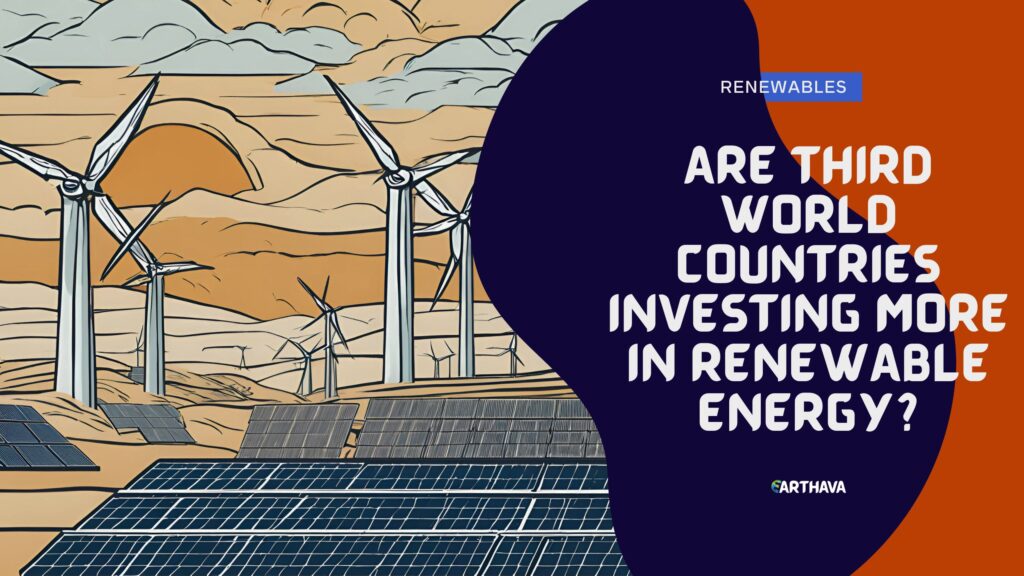In 2018, the world is witnessing developing countries taking the forefront in renewable energy investment. Third-world Countries like Afghanistan, Costa Rica, Albania, China, and India are transitioning towards renewable energy.

These emerging countries are bringing a revolution by pioneering this smart source of energy. The use of technology like solar software ecosystems like scoop.solar, facilitates from project start to operational efficiency and management of resources.
The Numbers Say It Loud
The REN21 report established that 2015 was the first year in which renewable energy investment in developing economies surpassed developed countries. Emerging economies invested over £345 million in renewables in 2015. Meanwhile, investment by developed countries declined by 8%. As per the report out of the total £196.5 billion expenditure on renewable energy over £107 billion occurred in Brazil, India, and China.
According to the Renewable Energy Country Attractiveness Index, Asia, Africa, and Latin America are the crux of renewable energy. Findings of the World Bank Group show that 89 million people residing in and Africa and Asia own at least one solar-powered product. In the coming 4 years, renewable energy in these areas is predicted to triple.
Reason for Increasing Renewable Energy Transition in Developing Countries:
- The cost of generating renewable energy falls, especially for solar photovoltaics and solar installers become easily
- The off-grid microsystems have made it easier to create electricity in remote areas.
- Installing and maintaining appliances have become easy as companies like solar installers have sprung up.
- Abundant renewable resources like solar, wind, and geothermal energy are available in developing nations.
- They also have the labor to set up systems that harness both the major plants and set micro home-based systems like solar panels.
- They want to reduce dependence on fossil fuels which are sensitive to price rises. Renewable sources are relatively cheaper for them and are leading to new markets like wind turbines, solar power, and solar installers.
- User-friendly software like Scoop. Solar makes use of the power of modern IT and renewable sources to implement the electricity generation process easily from plants to offices.
- Real-time data has become the essence of smart energy, and the latest technology is improving quality and speed. This has led to collaboration and access to analytics creating huge networks connecting through the Internet. Software together with artificial intelligence helps further in managing and optimizing energy needs
The Most Prominent Third World Countries Making a Mark in Renewable Energy are:
Bangladesh: It has the most significant market for solar home systems. It is experiencing rapid development in small-scale operations, like renewable energy mini-grids. Presently it has 4.5 million solar systems installed in the country. About one million systems per year were set up, benefiting 25 million citizens.
More than 100,000 jobs are provided in the home solar industry. It is recognized for the prominent role it plays in the global solar revolution. It sells and installs 35,000 units per month. By 2021 experts predict that the whole nation will be covered by solar.
China: It is one of the most dominating countries in the current renewable industry as its investment rose by 17% to $102.9 billion to which made 36% of the total worldwide investment. It will reach 40% of the overall renewable power mix globally by 2022 becoming the undisputed leader. A spiraling growth was seen in its clean energy segment as it tried to reduce its pollution. It hires 3.5 million people in the renewable energy sector while oil and gas only employ 2.6 million. It also dominates the market of PV solar installation together with the installed capacity
Morocco: It made the most use of its solar resource abundance and raised its renewable energy generation by $2 billion from almost nil in 2014. It is planning a $13 billion expansion of its renewable energy generation capacity so that by 2020 renewable energy makes 42% of its electricity.
India: It is amongst the top three nations producing renewable energy. Its investments rose by 22% to $10.2 billion in 2016 as Prime Minister Narendra Modi started the solar alliance in a climate conference held in Paris aiming to expand the solar installations by 2020 to 100GW from under 5GW. India now has more than 1827 solar installers spread nationwide. The government has set up targets to achieve 100 GW by 2022.
4 out of 7 of the largest global solar plants are situated in India. The solar park located in Kurnool, Andhra Pradesh is the world’s second-largest solar park having a capacity of 1000 MW. By the end of 2018, the largest solar plant in the world will be completed, with a capacity of 2255 MW at Bhadla Solar Park in Rajasthan. By 2022 wind power capacity in India will be doubled and solar power increase by 15 folds from 2016.
Costa Rica: It is close to becoming the first developing country to have 100 percent renewable electricity. 90% of the total energy output in the nation is through renewable energy. It is a world leader in windmill technologies having a massive stake in this renewable sector. It aims to become the first country in the world to be carbon neutral. It broke records in March 2015 when the whole nation ran on renewable power entirely for 75 days
Kenya: It became the world leader in the most amount of solar-generated systems set up per capital. Annually over 30,000 solar panels are traded in Kenya, as it has abundant solar energy to generate electricity this way. It is the most active renewable energy-using country in Africa. Geothermal energy makes up 20% of Kenyan grid capacity.
Brazil: About 85.4% of its electricity produced domestically was from renewable sources. It mainly focuses on wind power. It is involved in a global movement toward making wind power its major energy source.
Vietnam: Vietnam is a place where individuals are taking a stand towards renewable energy. Slum dwellers and villagers are harnessing wind power systems so that energy-consuming villages are reduced. Farmers are also producing solar-powered boats for fishing.


